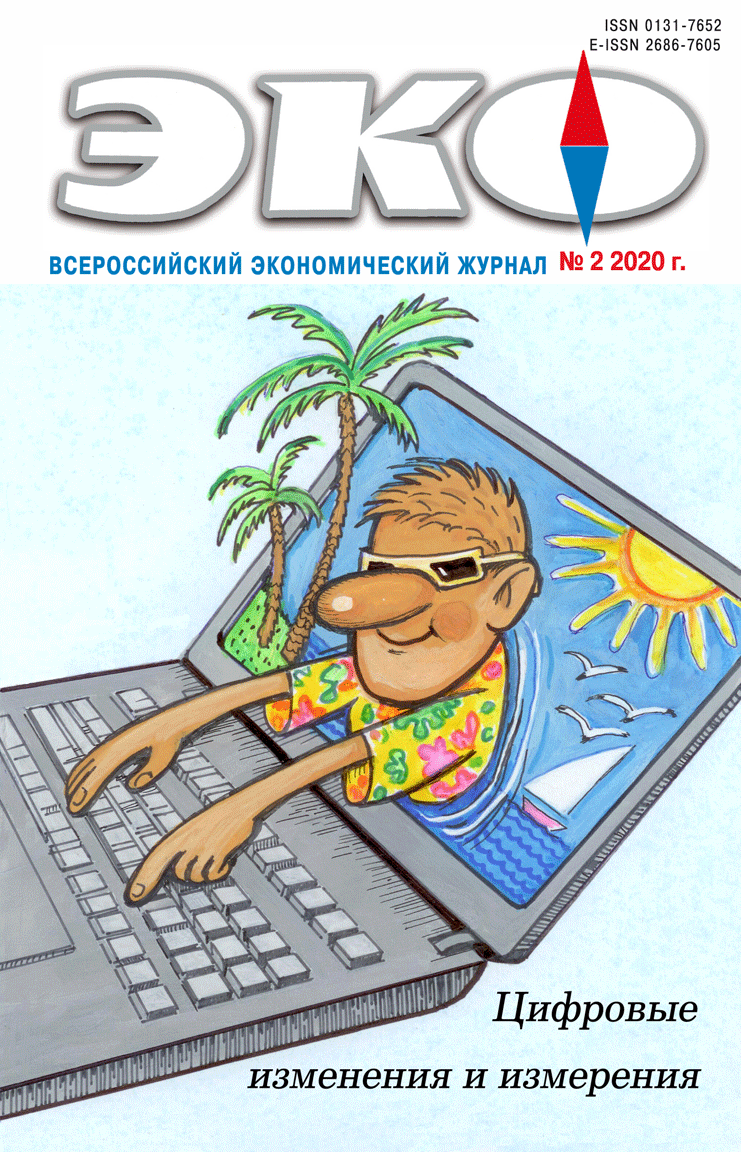Тема номера: Цифровые изменения и измерения
Published 2020-01-29
Keywords
- digital economy,
- Internet economy,
- ICT,
- OECD,
- methods for assessing the digital economy
- statistical accounting,
- information society,
- fourth industrial revolution,
- electronic economy,
- internet economy,
- hipe-cycle ...More
How to Cite
1.
Ganichev Н, Koshovec О. Quantifying the Digital Economy: Between Reality and Design. ECO [Internet]. 2020 Jan. 29 [cited 2025 Sep. 7];50(2):8-36. Available from: https://ecotrends.ru/index.php/eco/article/view/3970
Abstract
The term «digital economy» was introduced to the academic literature over 20 years ago and many governments adopted their national programs to develop digital economy proclaimed a new driver of global economic growth. However, the concept still has neither a clear definition, nor a single methodology for quantifying the digital economy as a statistical aggregate, which raises the issue of the real scope of this phenomenon. The authors believe that the digital economy is just a new business model and an ambitious global project of social and technological modernization of society at the intersection of political discourse and reality. This project has not yet materialized in the economy and exists as a constructed object of knowledge, statistical and forecast manipulation. The paper reviews the evolution of various concepts employed to define the digital economy and methods of its statistical quantification. The authors show that such methods have changed considerably depending on the economic environment. However, their main goal was to use any means (often at the expense of objectivity) in order to elaborate such a definition of the digital economy, which is gradually expanding to the level of almost entire economy, and to assess its scale in such a way as to continuously demonstrate high dynamics and accelerated growth rates.References
- Ганичев Н. А., Кошовец О. Б. Глобальная цифровая трансформация и ее цели: декларации, реальность и новый механизм роста // Экономическая наука современной России. 2018. № 4 (83). С. 126–143.
- Ganichev, N., Koshovets, O. (2018). Global Digital Transformation and its Goals: Declarations, Reality and the New Growth Mechanism. Ehkonomicheskaya nauka sovremennoi Rossii. Economics of Contemporary Russia. No. 4. Pp. 126–143. (In Russ.)
- Плаксин С., Абдрахманова Г., Ковалева Г. Интернет-экономика в России: подходы к определению и оценке // Форсайт. 2017. № 1. С. 55–65.
- Plaksin, S., Abdrakhmanova, G., Kovaleva, G. (2017). Approaches to Defining and Measuring Russia’s Internet Economy. Forsait. Foresight. No. 1. Pp. 55–65. (In Russ.).
- Abdrakhmanova, G., Kovaleva, G., Plaksin, S. (2016b). Approaches to Defining and Measuring Russia’s Internet Economy. Higher School of Economics Research Paper No. WP BRP 61/STI/2016. Available at: https://ssrn.com/abstract=2789532 or http://dx.doi.org/10.2139/ssrn.2789532 (accessed 01.08. 2019).
- Baller, S., Dutta, S., Lanvin, B. (eds.). (2016). The Global Information Technology Report 2016: Innovating in the Digital Economy. World Economic Forum. Geneva. 62 p.
- Brynjolfsson, E., Kahin, B. (eds.) (2000). Understanding the Digital Economy: Data, Tools, and Research. Cambridge: MIT Press. 408 p.
- Bukht, R. &Heeks, R. (2017). Defining, Conceptualising and Measuring the Digital Economy. International Organisations Research Journal. Vol. 13. Pp. 143–172. DOI: 10.17323/1996–7845–2018–02–07.
- Ganichev, N., Koshovets, O. (2019). Integrating Russia into the Global Project of Digital Transformation: Opportunities, Problems and Risks. Studies on Russian Economic Development. Vol. 30, No. 6. Pp. 627–636. DOI: 10.1134/S1075700719060030.
- Kling, R., Lamb, R. (2000). IT and Organizational Change in Digital Economies.In E. Brynjolfsson, B. Kahin (eds.). Understanding the Digital Economy. Cambridge: MIT Press. Pp. 295–324.
- Knorr-Cetina, K., Bruegger, U. (2000). The Market as an Object of Attachment: Exploring Postsocial Relations in Financial Markets. Canadian Journal of Sociology. Vol. 25. No. 2. Pp. 141–168.
- Margherio, L. et al. (1999). The Emerging Digital Economy. Washington, DC: Department of Commerce. Available at: http://govinfo.library.unt.edu/ecommerce/EDEreprt.pdf (accessed: 01.08.2019).
- Schwab, K. (2017). The fourth industrial revolution. London, Portfolio Penguin. P. 192 p.
- Tapscott, D. (1997). The Digital Economy: Promise and Peril in the Age of Networked Intelligence. New York, McGraw-Hill. 342 p.

